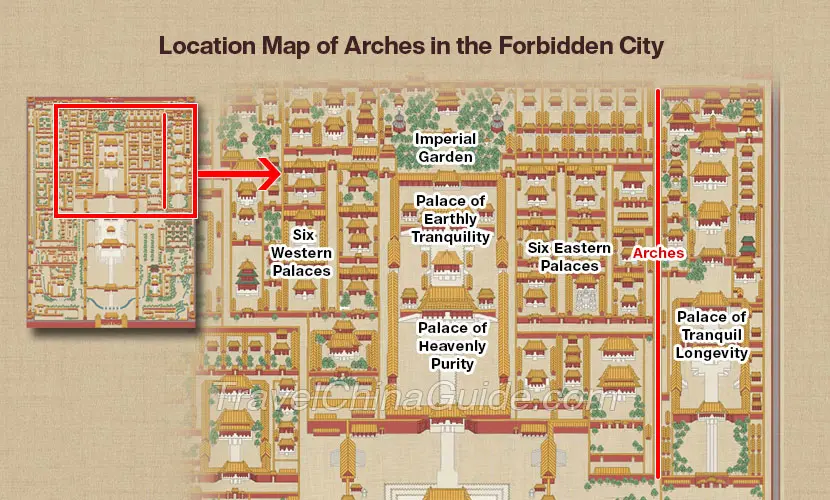Arches on the Wall of Forbidden City
 |
Watchhouses for Imperial Guards at Night
Some people say these arches were doors used to transport building materials; some people say that they are small doors for eunuchs and maids to remove garbage. Neither of them are right. Actually they were watchhouses for imperial guards at night, called Dui Bo in Manchu. The guards were on duty from 22:00 to next 05:00.
Along the west wall of the East Tongzi Alley, there are 8 and 12 arches to the north and south of the Cangzhen Gate respectively. Along the east wall, there are 9 both to the north and south of the Daohe Gate. The arches are not far from the gate, and the shortest distance is less than 2 meters (6.6 feet) from Daohe Gate. The two sides are not bilateral symmetrical for the guarding needs.
These arches are distributed in groups of two, three, four and five. The distance between each group is about 16 meters (52.5 feet) at most and about 8 meters (26.2 feet) at least. Each watchhouse is 1.43 - 1.78 meters (4.69 - 5.87 feet) wide, 2.2 - 2.5 meters (7.2 - 8.2 feet) high and 0.65-0.88 meters (2.13 - 2.89 feet) deep. Outside these watchhouses, there were also small wooden houses where weapons were stored and guards off-duty took rest and sought shelter from the wind and rain.
In 951, these watchhouses were blocked, leaving only the arches, and the nearby wooden houses were also tore own, in order to open up a fire lane.
Watchhouses in Other Parts of the Forbidden City
In addition to the above mentioned ones, watchhouses were set in the northwest corner of the Forbidden City, southeast of Fengxian Hall, northeast and northwest corner of Imperial Tea Room, front gate and back iron gate of Zhongzheng Hall and west of Palace of Peace and Longevity.
However, they are either in the non-touristy area of the Forbidden City, or have been completely blocked without traces. Tourists can now only see the arches on the wall of the East Tongzi Alley inside the Forbidden City.
Guards on Duty Should Be Very Concentrated
11 guards were on duty in each group of the watchhouses, equipped with 4 spears, 4 waist knives, a total of 4 bows, and 40 arrows. Guards shall not be absent from work or sleep on duty, and those who violated the rules would be severely punished, even involving their supervisors.
It is said that one day, when Emperor Qianlong (1711 - 1799) passed by these watchhouses, he suddenly decided to take a look of the imperial guards, but found a chessboard carved on the wooden door of a watchhouse. Obviously, there must be guards playing chess on the time of duty. Furiously, he ordered a strict inspection. At last, the guard was found out, beat on the buttocks as punishment and expelled from the imperial guard team. Also, his supervisor and the guards taking over the watchhouse were all implicated and punished.
However, when cleaning up the watchhouses before blocking in 1951, it was found that there were various inscriptions on their walls. Some recorded the number of bows and arrows stored in the houses, some recorded lyrical poems and interesting paintings, and some were records of personal debt. These tell that the imperial guards were very slacking by the end of Qing Dynasty (1636 - 1912).![]() Further Reading:
Further Reading:
Ancient Alarm System in the Forbidden City
Gutters on the Wall of Palace of Tranquil Longevity